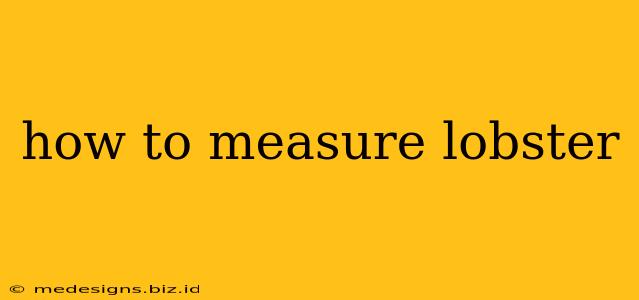Knowing how to properly measure lobster is crucial, whether you're a seasoned fisherman or a seafood enthusiast buying your catch. Accurate measurement ensures compliance with regulations, protects the lobster population, and guarantees you're getting the right size for your needs. This guide provides a step-by-step process for measuring lobsters, covering different techniques and addressing common concerns.
Why is Measuring Lobster Important?
Lobster populations are carefully managed to ensure sustainability. Size limits are put in place to protect breeding stock and allow smaller lobsters to grow to maturity. Failing to measure accurately can lead to fines or legal repercussions. Accurate measurement also helps consumers make informed choices when purchasing lobster, ensuring they get the size and weight they expect.
Key Considerations Before Measuring:
- Species: Different lobster species may have different size regulations. Ensure you're aware of the specific regulations for the species you're handling (e.g., American lobster, European lobster).
- Tools: You'll need a measuring device, typically a ruler or caliper, that's accurate and clearly marked in the required units (usually inches or centimeters). A sturdy surface is also beneficial to help keep the lobster still during the measurement process.
- Safety: Lobsters have strong claws. Handle them carefully and always prioritize your safety. Consider using gloves or other protective gear to avoid injury.
How to Measure Lobster: A Step-by-Step Guide
The most common method for measuring lobsters involves measuring their carapace length. This refers to the distance from the center of the eye socket to the rear edge of the carapace, which is the hard shell covering the lobster's body.
-
Secure the Lobster: Gently but firmly hold the lobster. It's safest to position it on a flat surface to prevent it from moving unexpectedly. If you are concerned about its claws, you can gently restrain them with a tool or towel.
-
Locate the Eye Socket: Identify the center of the lobster's eye socket. This is the starting point for your measurement.
-
Find the Rear Edge of the Carapace: Trace the carapace back to its end. The rear edge will be the furthest point along the lobster's back before the tail begins.
-
Measure the Carapace Length: Place your ruler or caliper along the carapace, starting at the center of the eye socket and extending to the rear edge. Take your measurement.
Understanding Lobster Size Regulations
Lobster size regulations vary widely depending on location and species. These regulations often specify a minimum carapace length below which lobsters must be released. Some areas may also have maximum carapace length limits. Always check with the relevant fisheries management authority to find the exact regulations for your area. Violation of these rules can result in significant penalties.
Measuring for Purchasing: Beyond Carapace Length
When purchasing lobster, while the carapace length is useful, you may also consider the overall weight. Weight is a good indicator of meat yield. Ask your vendor for the weight of the lobster if you need to ensure you are purchasing the right amount of meat.
Conclusion
Accurate measurement of lobsters is a crucial aspect of sustainable fishing and responsible seafood consumption. By following these steps and understanding relevant regulations, you can ensure you are complying with the law and contributing to the health of lobster populations. Remember to prioritize safety while measuring lobster and always check local regulations before catching or purchasing.
